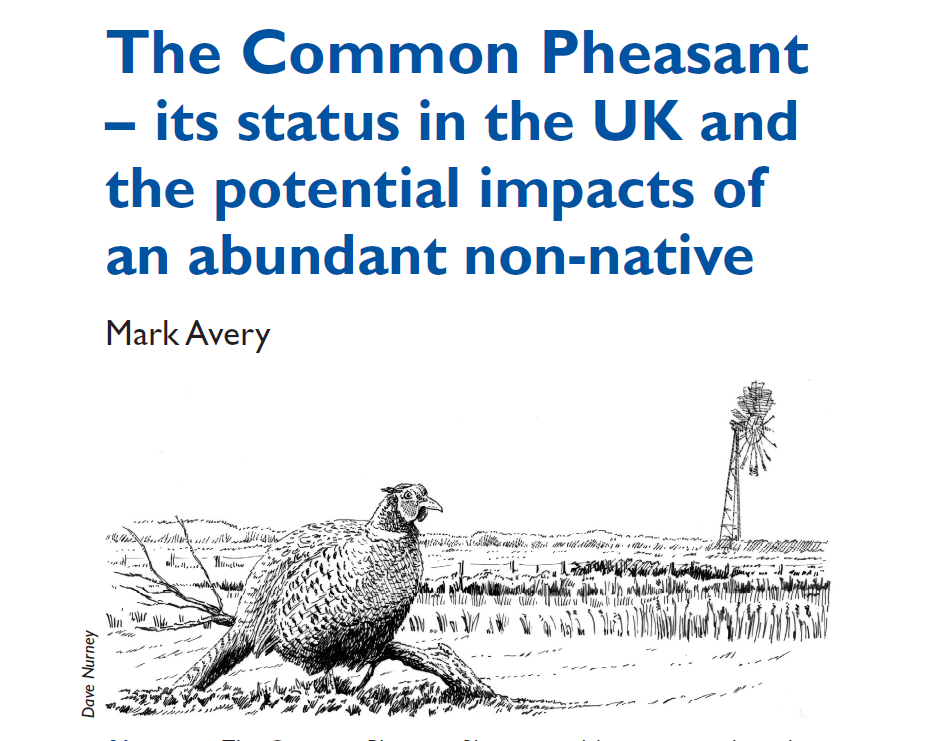
Here are a few quotes from the paper;
Since I am known for campaigning for a ban on driven grouse shooting, I should be clear that I am not in favour of banning Pheasant shooting.
Pheasants are naturalised in all European countries except Iceland. The European population, as measured in spring by national bird monitoring schemes, is around four million pairs of which c. 1.85 million (46%) are found in the UK.
Some 43 million Pheasants (almost all poults about nine weeks old, but with a very small proportion of adult birds from breeding stock) are released into the UK countryside in late summer (GWCT 2018a).… if we had never seen a Common Pheasant in the UK, and a proposal was made to release 43 million medium-sized omnivorous birds into the countryside, would it be nodded through without murmur? I think not, because we would be concerned about the potential impacts. (Far) more paperwork is needed to release a few individuals of a native species such as the White-tailed Eagle into the UK than to release 43 million non-native Pheasants each year. I suggest that we would put plenty of barriers in the way of such a massive release of non-native birds into the countryside if the situation had not crept up on us. This illustrates the lack of regulation of shooting in the UK.
We need more information on some of the concerns that are highlighted above. Who should investigate the issues? …. Perhaps government will do so but, in response to a FOI request in 2014, Defra stated: ‘Defra has not assessed the impact of releasing pheasants or red-legged partridges on biodiversity and is not currently planning any research in this area due to other biodiversity research priorities’.To my mind, there are two areas where we need no further research but instead action from government: the scale of releases and the use of lead ammunition.
More on this subject through the week.
But do have a listen to this podcast recorded with Charlie Moores on Lush radio – I think it is quite a good 30-minute listen.
[registration_form]
I read this twice, an excellent, well presented assessment of the situation which is long overdue. As a former part-time keeper, rough shooter and bird ringer I found much to reinforce my decision to give up sport shooting nearly thirty years ago and finally feel a sense of vindication. The only point I would take issue with is the relationship between driven pheasant shooting and wildlife crime; while it is possibly not as systemic as that associated with driven grouse shooting, it is still a feature and, given the nature of the environment where it happens, can be all to easy to conceal. Well done, Mark for highlighting the inconsistencies, expect some flak from all the naysayers!!
It’s a subject I’ve thought about for a long time. I’d like to see a complete ban on releasing pheasants for shooting or any other reason. As you say, try getting permission to release captive-reared native species and see how difficult it is. Why not simply shoot all the ones already out there? Personally, I would like to see a move towards a more civilised society where killing things for pleasure and “sport” is socially unacceptable and eventually dies out. Meantime(!) why not release a few hundred Hen Harriers as there is habitat for them and the shooting industry is all in favour of them?
Where there is a major development happening near a pheasant release site, then, the impact of the released pheasants should be considered as being cumulative with the impacts of the proposed development.
There is scope to catch them in the system.
My own view is quite simple, mass release of Pheasants ( and RL Partridges) has an as yet largely unknown effect on our native ecology, I would follow the Dutch lead on this and ban the releases but not the shooting. I too think that wildlife crime whilst not as obvious as it is in Grouse management is nonetheless rife in pheasant shooting, especially the killing of Goshawks.
No pheasants in Estonia either – bar two possible breeding attempts recorded in 2018 atlas. Worth visiting just to see what countryside without pheasants looks like!
What about the rearing, release and shooting of pheasants on SSSI’s (and NNR’s) Mark?
Surely that should be stopped?
(Maybe you address this in your paper which I confess I’ve not read yet….)